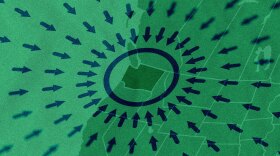The Puget Sound region is experiencing a record “episodic tremor and slip” event, according to the Pacific Northwest Seismic Network.
These are a series of mini-earthquakes that cruise along a fault, such as the major one running under the Northwest coastline. That’s where the Juan De Fuca plate off shore is colliding with the North American plate and pushing under it.
“This is the continuing saga of the episodic tremor and slip that was spotted about 10 years ago,” said John Vidale, the network’s director and Washington State Seismologist.
A noteworthy event
The current episodic tremor and slip event started Aug. 30 and is also unique because it started under the Vancouver Island and cruised south to below Centralia – and is still going.
“We thought we knew the pattern pretty well, that it would start down in the south Puget Sound, spread out for a couple of weeks, mainly going north under the Vancouver Island,” Vidale said. “This time broke the pattern … It started in the north and came south. It is also the biggest episode we’ve seen yet.”
While still a couple days from being the longest running event, the series of tremors is now the most active, the network reported on its blog.
“Just another 10 percent or so (bigger), so far, beyond the previous biggest one,” Vidale said. He added that GPS readings show that the ground is moving east a little more than before as well.
The ‘Big One’?
This year’s unique tremors may or may not bring the “big one” – the “once-every-500-years-or-so” quake – any closer, Vidale said.
The boundary between the two plates starts with a trench offshore and angles under us here in the Puget Sound area and stretches from California up to Canada.
“The shallow part of that is brittle, which is where we have our magnitude 9 earthquakes and a little bit deeper on that boundary is where we have this episodic tremor and slip,” Vidale explained.
The journal “Earth” explains the cycle of major quakes and damage potential in its recent story focused on Puget Sound area efforts – “Seismic citizens: Volunteers host home-based seismometers to help assess earthquake threat.”
For decades, seismologists have been uncovering paleoseismic evidence of numerous major earthquakes that have occurred on the Cascadia subduction zone, most recently in 1700. Sunken “ghost” forests and anomalous inland sand deposits indicate the sudden topographic collapse that accompanied the quakes and drastically altered the landscape. Recurrence intervals among the largest of these events hint at something big in the offing.
Whether it will happen in two years, 200 years or even further down the road is unknown, but damage scenarios for either a subduction-related megathrust earthquake or a significant rupture on one of the many faults that traverse the shallow subsurface are worrisome. Given the present state of the area’s infrastructure, the expected shaking and the area over which it would be felt, it shouldn’t be surprising that “the most complex, costly, dangerous [hazard] that’s going to happen here is a really big earthquake,” says Barb Graff, director of the Seattle Office of Emergency Management.
The Pacific Northwest Seismic Networks has several webpages exploring the 1700 megathrust earthquake through archaeological evidence and Native American oral histories.
Native traditions tell of shaking and flooding along the Cascadia coast and estimate the date of the last earthquake by using stories that count the number of generations since its occurrence, the network explains. These stories are common among the native people in the Pacific Northwest.
Video: The largest earthquake in recent history in Washington was the 6.8 Nisqually earthquake in 2001.
http://www.youtube.com/watch?v=PY5Rm5TGNy0
How important is the current event?
The latest tremor and slip event could be adding an increment of stress to the faults that are “loading up” along our coast or it “… might not have any effect at all.”
Mostly, for the general public, it’s a good reminder that the big one is out there … somewhere.
“I think people have in the back of their mind that it’s possible and it comes so infrequently that it’s hard to invest a lot of immediate effort to prepare,” he said.
“A fraction of the people here are a little bit hysterical worried about it. A large fraction of the people just don’t get ready at all. So, you know, if it reminds people of the danger that’s great, but if it scares people, that’s not so great.”
Previous report by KPLU's Keith Seinfeld:
On the Web:







